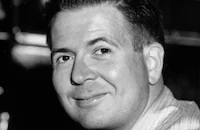Beginning of the End
Brief Synopsis
Cast & Crew
Bert I. Gordon
Peter Graves
Peggie Castle
Morris Ankrum
Than Wyenn
Thomas B. Henry
Photos & Videos
Film Details
Technical Specs

Synopsis
When police officers discover that the town of Ludlow, Illinois has been mysteriously wiped out, the Illinois National Guard cordons off the surrounding area. Renowned reporter Audrey Aimes is on her way to cover a story in the Ludlow vicinity, and after she is turned back at a roadblock, she drives to Guard headquarters to request permission to enter the area. At headquarters, Col. Tom Sturgeon makes Audrey promise to withhold her story pending government approval, then tells her that Ludlow has been destroyed and its 150 residents have vanished. Audrey notifies her editor in New York, who discovers that the Department of Agriculture has set up an experimental lab near Ludlow. Driving to the lab, Audrey meets deaf-mute scientist Frank Johnson and Dr. Ed Wainwright, the project director, who shows her the giant plants he has grown using radioactive feed. Later, after seeing the ravaged town and learning that a grain warehouse in the area met a similar fate three months earlier, Audrey asks Ed to take her to the warehouse. Frank accompanies them there, and points out that the ground is unusually barren. As Frank wanders around the site, a giant grasshopper appears and attacks him. Escaping the insect's clutches, Ed and Audrey speed to Guard headquarters to inform the colonel that giant grasshoppers have destroyed both the warehouse and the town. When Ed asserts that normal-sized grasshoppers must have entered his lab and ingested the radioactive plant food, turning them into giants, the colonel dismisses his account, but sends Capt. James Barton and some guardsmen to investigate. After Ed leads them to the spot in which Frank was devoured, the captain and his troops fan out into the woods. Soon, giant grasshoppers attack, sending the men scurrying back to their truck. Feeling responsible for the creation of a threat that "may mean the annihilation of man," Ed flies with Audrey to Washington, D.C. where he reports to a military committee that, although the insects are unable to fly, their powerful jaws and sharp teeth allow them to devour men. The military is content to have the Guard handle the situation until news comes that another town, just one hundred miles from Chicago, has been destroyed. Realizing that it is imperative to stop the grasshoppers before they reach Chicago, Gen. John Hanson calls in the armored and airborne divisions and flies back to Chicago with Ed and Audrey. When heavy artillery fire fails to halt the advance of the grasshoppers, people begin to panic in the streets of Chicago. As night falls and the temperature drops, the grasshoppers become immobile from the cold and huddle in alleyways. Knowing that they will start moving again once the sun rises, the general decides to evacuate the city and drop an atomic bomb at dawn. Desperate to avoid the desolation caused by an atomic bomb, Audrey suggests driving the grasshoppers into the lake where they will drown. Because the grasshoppers emit a high-pitched sound to rally for an attack, Ed decides to try to replicate the sound to lure them into the lake. Taking to the alleyways to capture one of the creatures, Ed and several soldiers trap a specimen and take it back to a building in which Ed has constructed a makeshift lab. After locking it in a cage, Ed exposes it to a series of sound frequencies, hoping to replicate its call. Hours later, the insect has still not reacted, and the general orders the bombers into the air. With only minutes remaining before dawn, Ed finally duplicates the correct frequency, causing the insect to rampage and break out of its cage. Ed shoots it with a machine gun, then notifies the general that he has replicated the grasshoppers' high-pitched drone. While an amplifier is erected on the tallest roof in Chicago, the general fits a boat with sound equipment and heads out onto the lake. When the temperature rises above sixty-eight, the grasshoppers begin to move, and heeding the call emanating from the amplifier, march toward it. Once the grasshoppers congregate downtown, the general activates the amplifier on this boat, luring the insects to their deaths in the water.

Director

Bert I. Gordon
Cast

Peter Graves

Peggie Castle

Morris Ankrum
Than Wyenn
Thomas B. Henry

Richard Benedict
James Seay
John Close
Don C. Harvey
Larry J. Blake
Eilene Janssen
Hylton Socher
Frank Wilcox
Douglas Evans
Paul Grant
Richard Emory
Hank Patterson
Steve Warren
Frank Connor
Don Eitner
Rayford Barnes
Frank Chase
Alan Reynolds
Alan Wells
Patricia Dean
Crew
Lou Bartel
Steve Drumm
George J. Eppich
Fred Freiberger
Albert Glasser
Bert I. Gordon
Bert I. Gordon
Lester Gorn
James Harris
Austin Herrick
Harriet Kane
Walter Keller
Jack Marta
Morris K. Mcnaughton
George Milo
Melville Shyer
Wilson Shyer
Aaron Stell
Douglas Stewart
Richard E. Tyler

Photo Collections
Film Details
Technical Specs

Quotes
Trivia
Notes
Beginning of the End marked the first production by AB-PT Pictures Corp., a subsidiary of the American Broadcasting-Paramount Theatres organization. According to an American Cinematographer article, producer-director Bert I. Gordon had to locate a wingless variety of grasshoppers that could not fly or hop so that they could not escape during filming. He imported 200 from Texas, and at the end of production only twelve were still alive. The scene in which the grasshoppers swarm the high-rise building in Chicago was created by placing the grasshoppers on a large photo cutout of a building. The Variety review misspells Peggie Castle's name as "Peggy" and incorrectly credits Pierre Watkin as "Taggert." Modern sources add Kirk Alyn, Bill Baldwin, Sr., James Douglas, Lyle Latell, Dennis Moore, Zon Murray, Ralph Sanford and Bert Stevens to the cast.

Miscellaneous Notes
Released in United States Summer June 1957
Released in United States Summer June 1957











